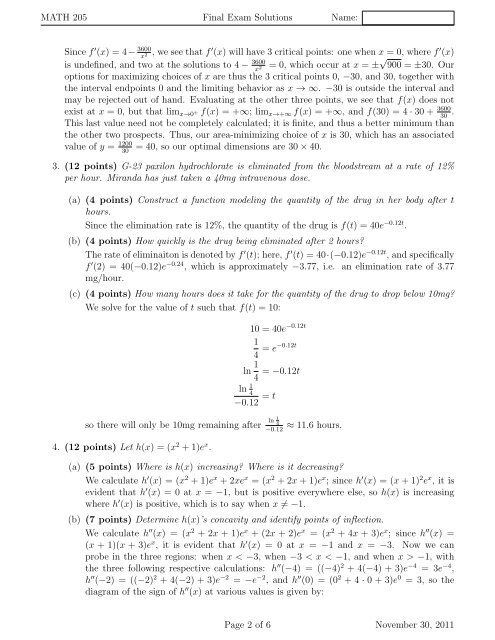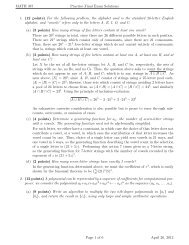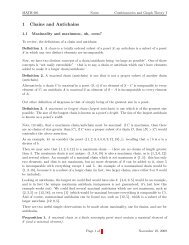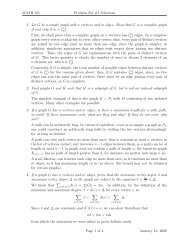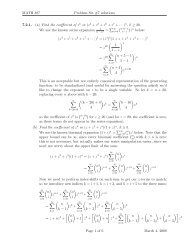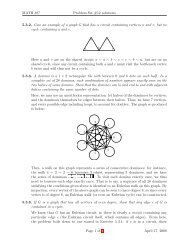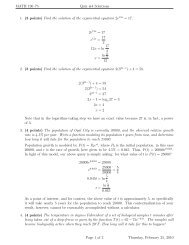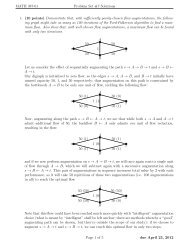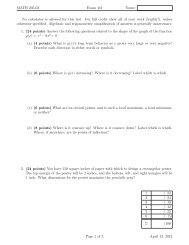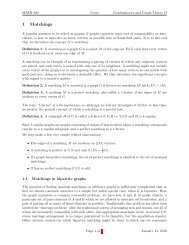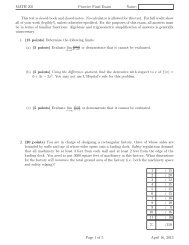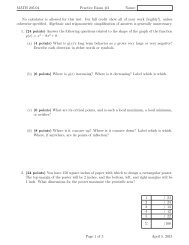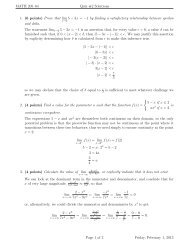MATH 205 Final Exam Solutions Name: 1. (12 points) The keratoid ...
MATH 205 Final Exam Solutions Name: 1. (12 points) The keratoid ...
MATH 205 Final Exam Solutions Name: 1. (12 points) The keratoid ...
You also want an ePaper? Increase the reach of your titles
YUMPU automatically turns print PDFs into web optimized ePapers that Google loves.
<strong>MATH</strong> <strong>205</strong> <strong>Final</strong> <strong>Exam</strong> <strong>Solutions</strong> <strong>Name</strong>:<br />
Since f ′ (x) = 4− 3600 , we see that f ′ (x) will have 3 critical <strong>points</strong>: one when x = 0, where f ′ (x)<br />
x 2<br />
is undefined, and two at the solutions to 4 − 3600 = 0, which occur at x = ± √ 900 = ±30. Our<br />
x 2<br />
options for maximizing choices of x are thus the 3 critical <strong>points</strong> 0, −30, and 30, together with<br />
the interval end<strong>points</strong> 0 and the limiting behavior as x → ∞. −30 is outside the interval and<br />
may be rejected out of hand. Evaluating at the other three <strong>points</strong>, we see that f(x) does not<br />
exist at x = 0, but that lim x→0 + f(x) = +∞; lim x→+∞ f(x) = +∞, and f(30) = 4 · 30 + 3600.<br />
30<br />
This last value need not be completely calculated; it is finite, and thus a better minimum than<br />
the other two prospects. Thus, our area-minimizing choice of x is 30, which has an associated<br />
value of y = <strong>12</strong>00 = 40, so our optimal dimensions are 30 × 40.<br />
30<br />
3. (<strong>12</strong> <strong>points</strong>) G-23 paxilon hydrochlorate is eliminated from the bloodstream at a rate of <strong>12</strong>%<br />
per hour. Miranda has just taken a 40mg intravenous dose.<br />
(a) (4 <strong>points</strong>) Construct a function modeling the quantity of the drug in her body after t<br />
hours.<br />
Since the elimination rate is <strong>12</strong>%, the quantity of the drug is f(t) = 40e −0.<strong>12</strong>t .<br />
(b) (4 <strong>points</strong>) How quickly is the drug being eliminated after 2 hours?<br />
<strong>The</strong> rate of eliminaiton is denoted by f ′ (t); here, f ′ (t) = 40·(−0.<strong>12</strong>)e −0.<strong>12</strong>t , and specifically<br />
f ′ (2) = 40(−0.<strong>12</strong>)e −0.24 , which is approximately −3.77, i.e. an elimination rate of 3.77<br />
mg/hour.<br />
(c) (4 <strong>points</strong>) How many hours does it take for the quantity of the drug to drop below 10mg?<br />
We solve for the value of t such that f(t) = 10:<br />
10 = 40e −0.<strong>12</strong>t<br />
1<br />
4 = e−0.<strong>12</strong>t<br />
ln 1 4 = −0.<strong>12</strong>t<br />
ln 1 4<br />
−0.<strong>12</strong> = t<br />
so there will only be 10mg remaining after ln 1 4<br />
−0.<strong>12</strong><br />
4. (<strong>12</strong> <strong>points</strong>) Let h(x) = (x 2 + 1)e x .<br />
≈ 1<strong>1.</strong>6 hours.<br />
(a) (5 <strong>points</strong>) Where is h(x) increasing? Where is it decreasing?<br />
We calculate h ′ (x) = (x 2 + 1)e x + 2xe x = (x 2 + 2x + 1)e x ; since h ′ (x) = (x + 1) 2 e x , it is<br />
evident that h ′ (x) = 0 at x = −1, but is positive everywhere else, so h(x) is increasing<br />
where h ′ (x) is positive, which is to say when x ≠ −<strong>1.</strong><br />
(b) (7 <strong>points</strong>) Determine h(x)’s concavity and identify <strong>points</strong> of inflection.<br />
We calculate h ′′ (x) = (x 2 + 2x + 1)e x + (2x + 2)e x = (x 2 + 4x + 3)e x ; since h ′′ (x) =<br />
(x + 1)(x + 3)e x , it is evident that h ′ (x) = 0 at x = −1 and x = −3. Now we can<br />
probe in the three regions: when x < −3, when −3 < x < −1, and when x > −1, with<br />
the three following respective calculations: h ′′ (−4) = ((−4) 2 + 4(−4) + 3)e −4 = 3e −4 ,<br />
h ′′ (−2) = ((−2) 2 + 4(−2) + 3)e −2 = −e −2 , and h ′′ (0) = (0 2 + 4 · 0 + 3)e 0 = 3, so the<br />
diagram of the sign of h ′′ (x) at various values is given by:<br />
Page 2 of 6 November 30, 2011


